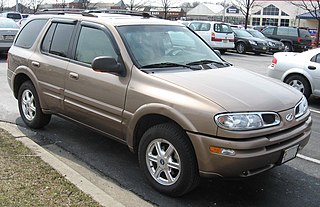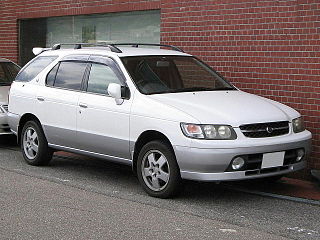
The Honda CR-X, originally launched as the Honda Ballade Sports CR-X in Japan, is a front-wheel-drive sport compact car manufactured by Honda from 1983 until 1991. The first generation CRX was marketed in some regions outside Japan as the Honda Civic CRX. Although there are many supposed definitions for the acronym CR-X, the most widely accepted is "Civic Renaissance Experimental".
Fuel efficiency is a form of thermal efficiency, meaning the ratio of effort to result of a process that converts chemical potential energy contained in a carrier (fuel) into kinetic energy or work. Overall fuel efficiency may vary per device, which in turn may vary per application, and this spectrum of variance is often illustrated as a continuous energy profile. Non-transportation applications, such as industry, benefit from increased fuel efficiency, especially fossil fuel power plants or industries dealing with combustion, such as ammonia production during the Haber process.

The Honda Insight is a hybrid electric vehicle that is manufactured and marketed by Honda. Its first generation was a two-door, two passenger liftback (1999–2006) and in its second generation was a four-door, five passenger liftback (2009–2014). In its third generation, it became a four-door sedan (2019–present). It was Honda's first model with Integrated Motor Assist system and the most fuel efficient gasoline-powered car available in the U.S. without plug-in capability — for the length of its production run.

The Oldsmobile Bravada is a front-engine, four-door mid-size SUV manufactured and marketed by the Oldsmobile division of General Motors — across three generations and as a rebadged variant of the Chevrolet Blazer and GMC Jimmy. It was the only SUV manufactured or marketed by Oldsmobile, and the first light truck offered in the United States by a GM brand other than Chevrolet or GMC since before World War II.

The Toyota RAV4 EV is an all-electric version of the popular RAV4 SUV produced by Toyota until 2014. Two generations of the EV model were sold in California, and to fleets elsewhere in the US, with a gap of almost ten years between them.

The Ford Fusion Hybrid is a gasoline-electric hybrid powered version of the mid-sized Ford Fusion sedan manufactured and marketed by Ford, now in its second generation. A plug-in hybrid version, the Ford Fusion Energi, was released in the U.S. in February 2013.
The General Motors Ultralite was a 1992 low emission vehicle concept car intended to demonstrate the benefits of advanced materials and low fuel consumption.

The Ford C-Max is a compact multi-purpose vehicle (MPV) produced by the Ford Motor Company from 2003 to 2019. The Ford Grand C-Max has a longer wheelbase.

The Hyundai Scoupe is a 2-door coupé based on the Hyundai Excel. The name, a portmanteau of "sporty" and "coupe," was pronounced "scoop". In the UK and other countries it is known as an "S Coupé". It was sold in the US from December 1988 through 1995. An 81 horsepower, 1.5L Mitsubishi sourced I4 engine provided power to the front wheels via a 5-speed manual or 4-speed automatic transmission.
Shell Eco-marathon is a world-wide energy efficiency competition sponsored by Shell. Participants build automotive vehicles to achieve the highest possible fuel efficiency. There are two vehicle classes within Shell Eco-marathon: Prototype and UrbanConcept. There are three energy categories within Shell Eco-marathon: battery-electric, hydrogen fuel cell, and internal combustion engine. Prizes are awarded separately for each vehicle class and energy category. The pinnacle of the competition is the Shell Eco-marathon Drivers' World Championship, where the most energy-efficient UrbanConcept vehicles compete in a race with a limited amount of energy.

The Nissan R'nessa is a station wagon manufactured by Nissan Motors from 1997 to 2001. According to Nissan, the name derives from "packaging renaissance for versatile, spacious comfort on wheels."

The Saturn Relay is a minivan that was made by General Motors. It was introduced for the 2005 model year, and was built alongside badge engineered variants, the Buick Terraza, the Chevrolet Uplander, and the Pontiac Montana SV6 in Doraville, Georgia.

The fuel economy of an automobile relates distance traveled by a vehicle and the amount of fuel consumed. Consumption can be expressed in terms of volume of fuel to travel a distance, or the distance traveled per unit volume of fuel consumed. Since fuel consumption of vehicles is a significant factor in air pollution, and since importation of motor fuel can be a large part of a nation's foreign trade, many countries impose requirements for fuel economy. Different methods are used to approximate the actual performance of the vehicle. The energy in fuel is required to overcome various losses encountered while propelling the vehicle, and in providing power to vehicle systems such as ignition or air conditioning. Various strategies can be employed to reduce losses at each of the conversions between the chemical energy in the fuel and the kinetic energy of the vehicle. Driver behavior can affect fuel economy; maneuvers such as sudden acceleration and heavy braking waste energy.

The energy efficiency in transport is the useful travelled distance, of passengers, goods or any type of load; divided by the total energy put into the transport propulsion means. The energy input might be rendered in several different types depending on the type of propulsion, and normally such energy is presented in liquid fuels, electrical energy or food energy. The energy efficiency is also occasionally known as energy intensity. The inverse of the energy efficiency in transport, is the energy consumption in transport.

Andrew Alfonso Frank is an emeritus American professor of Mechanical and Aeronautical Engineering at University of California, Davis. He is recognized as the father of modern plug-in hybrids, and coined the now-common term Plug-in Hybrid Electric Vehicle (PHEV). He has a B.S.M.E degree (1955) from the University of California, Berkeley, a M.S.M.E (1958), from the University of California, Berkeley, an M.S.E.E (1965) from the University of Southern California, and holds a Ph.D. in E.E (1968) from the University of Southern California. Frank worked at North American Aviation then North American/Rockwell Aviation from 1955 to 1968 on programs such as the X15 Research Aircraft, Helicopter stability and control systems, the Apollo Project to the moon, and the Minuteman intercontinental ballistic missile programs. He received patents and provided many innovations and solutions that allowed the programs to be more successful and effective. His patents continue to be in use today.

The H-M-Vehicles Free-Way was a three-wheel microcar manufactured in Burnsville, Minnesota, from 1979 to 1982.

Miles per gallon gasoline equivalent is a measure of the average distance traveled per unit of energy consumed. MPGe is used by the United States Environmental Protection Agency (EPA) to compare energy consumption of alternative fuel vehicles, plug-in electric vehicles and other advanced technology vehicles with the energy consumption of conventional internal combustion vehicles rated in miles per U.S. gallon.

The Cadillac Urban Luxury Concept (ULC) is a gasoline-electric hybrid, 4-seater, city concept car from Cadillac unveiled at the 2010 Los Angeles Auto Show. The vehicle features touchpad screens and projected displays that take the place of traditional gauges.

The BMW E31 is the first generation of the BMW 8 Series. It is a grand tourer built by BMW from 1990 to 1999 powered by either a V8 or V12 engine. Whilst it did supplant the original E24 based 6 Series in 1990, it was not a direct successor, but a new model class with a substantially higher price and performance than the 6 Series.

The third generation Honda CR-V was launched for the 2007 model year. It went on sale in the U.S. during late September 2006. Unlike preceding models, it features a rear liftgate rather than a side-opening rear door and no longer has the spare tire mounted on the rear door. The new CR-V is lower, wider and shorter than the previous models; the length decrease is attributed mostly to the fact that the spare wheel no longer adds length to the back of the vehicle. A lowering of the center of gravity is another benefit of the spare wheel being located underneath the rear cargo area. The center rear seat pass-through was also introduced as a new feature on the third generation.

















